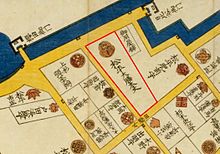Mōri (clan)
The Mōri ( Japanese 毛利氏 , Mōri-shi ) were a family of the Japanese sword nobility ( Buke ), who descended from the Aki province and which was derived from Ōe no Hiromoto (1148-1225). With an income of 369,000 Koku , the Mōri residing in Hagi were among the great Tozama daimyō of the Edo period . Their name was traced back from the fiefdom ( Shōen ) Mōri in the district of Aikō in the province of Sagami . The generation of Hiromoto therefore began to refer to themselves as Mōri because of their origins.
history
Heian period
After the Jōkyū War , the Mōri were appointed administrators ( Jitō ) of a fief in Aki Province.
Kamakura time
In the Kamakura period , the Mōri were a prominent family among the Gokenin (servants of the Shōgun who were below the Hatamoto in the hierarchy , but above the simple samurai ) because of the fame of their ancestor Hirotomo . At the end of the Kamakura shogunate , the Mōri had moved away from the shogunate and showed a rapprochement with Ashikaga Takauji .
-
Suemitsu ( 季 光 ; 1202-1247). Son of Hiromoto, the first to take the name Mōri.
- Tokichika ( 時 親 )
Genealogy from the Sengoku period
Motonari ( 元 就 ; 1497–1571) succeeded in the Sengoku period in expanding his power to the entire province of Aki and then to the neighboring provinces. Mōri was transformed from a local gokenin to a daimyo.
-
Takamoto ( 隆 元 ; 1523–1563)
-
Terumoto ( 輝 元 ; 1553-1625). Since Takamoto died before Motonari, Terumoto succeeded his grandfather. In the civil war years he fought on Toyotomi Hideyoshi's side and built his residence in Hiroshima in 1591, had a considerable income of 1,200,000 koku. After a dispute with Toyotomi Hideyoshi, a general of Oda Nobunaga , both sides made peace and Mōri remained a daimyo of five provinces in the Chūgoku region . He became one of the five who took over the tutelage of Hideyoshi's son and led, at least nominally, the Western Army at the Battle of Sekigahara in 1600 . After the defeat, he lost eight of his provinces except for Nagato and Suō.
-
Hidenari ( 秀 就 ; 1595–1651) (1)
-
Narihiro (斎 広; 1814–1836), descendant of Hidenari, also emerged as a scholar and wrote several books.
- Motonori (元 徳; 1839-1896), son of Mōri Hiroshige from the branch line based in Tokuyama, was adopted in 1851 by Yoshichika, brother and successor of Narihiro. He was one of the leading figures who brought about the overthrow of the shogunate. After 1868 Duke.
-
Narihiro (斎 広; 1814–1836), descendant of Hidenari, also emerged as a scholar and wrote several books.
-
Hidenari ( 秀 就 ; 1595–1651) (1)
-
Terumoto ( 輝 元 ; 1553-1625). Since Takamoto died before Motonari, Terumoto succeeded his grandfather. In the civil war years he fought on Toyotomi Hideyoshi's side and built his residence in Hiroshima in 1591, had a considerable income of 1,200,000 koku. After a dispute with Toyotomi Hideyoshi, a general of Oda Nobunaga , both sides made peace and Mōri remained a daimyo of five provinces in the Chūgoku region . He became one of the five who took over the tutelage of Hideyoshi's son and led, at least nominally, the Western Army at the Battle of Sekigahara in 1600 . After the defeat, he lost eight of his provinces except for Nagato and Suō.
- Motoharu ( 元 春 ; 1530–15861) → Kikkawa ( 吉川氏 ) in Iwakuni , Suō Province
- Takakage ( 隆 景 ; 1532–1596) → Kobayakawa ( 小早川 氏 )
- Motoaki ( 元 秋 ; 1552–1585)
- Motoyasu ( 元 康 ; 1560–1601). He followed his brother, who had died childless. The line ends with him.
- Motokiyo ( 元 清 ; 1551–1597)
- Motomasa ( 元 政 ; 1559–1609)
-
Hidekane ( 秀 包 ; 1566–1601)
-
Motonobu
- Motofusa (4)
-
Motonobu
Edo period
From the Tokugawa shogunate they were referred to as Tozama daimyo .
Meiji period
After the Meiji Restoration , in which the Mōri were significantly involved, the system of Han and daimyō was abolished. The head of the Mōri was now dubbed Kōshaku ( 公爵 , prince ).
Important personalities
Remarks
- ↑ The main line inherited the court title "Daizen tayū" ( 大 膳 太 夫 ).
swell
- ↑ a b T. Furusawa: Kamon daicho . Kin'ensha, n.d., ISBN 4-321-31720-7 , p. 78.
- ↑ See sonpi bunmyaku , Vol. 3, pp. 97-104. Quoted in: Herbert Plutschow: Japan's Name Culture. The Significance of Names in a religious, Political and Social Context. Curzon 1995.
- ^ Edmond Papinot: Historical and Geographical Dictionary of Japan. Reprint of the original 1910 edition by Tuttle, 1972. ISBN 0-8048-0996-8 . P. Xxx.
literature
- Masazuki Miura: Shiro to jinya. Saikoku-hen. Gakken, 2006. ISBN 4-05-604379-5 .





